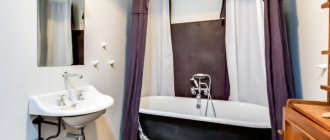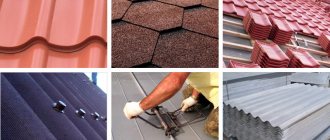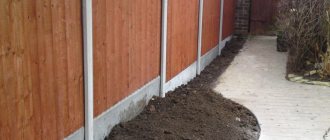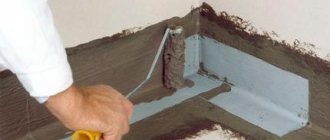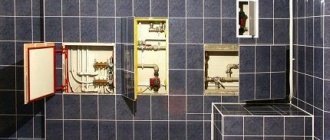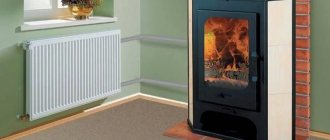- What are acrylic and enamel
- Use of polystyrene foam
- Polypropylene pipes
- Conclusion
This is actually a problem - how to strengthen the shower tray with your own hands. Metal is very flexible, and the polymer coating, not to mention enamel, is not very elastic. As a result, when you stand on the pallet with your feet, you risk getting a spider web of cracks. Which not only worsens performance properties, but also looks so-so.
How to strengthen the bottom with your own hands? There are many ways to do this, and we are going to look at them.
Shower tray with legs
Use of bricks and hard materials
If you are faced with the question of how to raise a bathtub above the floor level to a considerable height, then installation on solid materials would be a suitable version. The advantages of this method include:
- increasing the area of racks;
- sustainability;
- eliminating structural deformation;
- installation of plumbing fixtures at any height;
- creating the desired slope.
Basically, this method involves the construction of supports made of brick and other materials that have sufficient strength. Brick stands are constructed using mortar. This allows you to give them stability and strength.
As an addition, walls are used that surround the plumbing around the perimeter. This method makes it possible to perform reliable installation of the bathtub, regardless of its weight. At the same time, it looks quite aesthetically pleasing. The space under the plumbing is completely hidden behind the brick wall.
Important! If materials with low moisture resistance are used for installation, then additional insulation work must be performed. This will protect the supporting elements from the negative effects of high humidity.
Purpose of shower trays
Universal pallets are an integral element of shower cabins and corners, and can also be used as an independent sanitary installation. The main purpose of a shower tray is to reliably protect the flooring and walls of a sanitary room from water splashes.
Intense water pressure can cause deformation of the external facades of furniture and cosmetic finishing of a bathroom or bathroom.
In addition to its direct functions, the shower tray contributes to the hygiene and safety of the bathroom. In sanitary rooms with high humidity, where there is no drain pan, the junctions between walls and floor coverings are filled with stagnant water. It creates a favorable environment for the proliferation of bacteria and harmful microorganisms.
Installing the structure will eliminate the possibility of the formation of fungi and the proliferation of microbes. When equipping a separate area for showering, the owner of the room will have to choose the most comfortable and easy-to-use and maintain equipment and equipment.
It is especially important to choose the optimal model of shower tray for your sanitary and hygienic premises, suitable for all parameters - height, width, depth
First of all, shower trays perform their direct functions - they provide collection and drainage of running, used water.
The tray is the main element of the shower box, which performs a number of functions:
- plays the role of a “foundation” for the installation of fences and acts as a connecting link between doors and walls;
- eliminates mechanical impact on the drainage system installed in the shower;
- due to the tightness and reliability of the design, it allows you to safely take water procedures;
- acts as a heat insulator between human feet and the concrete floor;
- a wide selection of sizes and shapes will satisfy every buyer’s taste;
- you can choose the optimal model of tray for a small bathroom or a spacious apartment;
- the pallet can harmoniously fit into the interior or become an accenting design element.
By installing a shower tray, you can significantly improve the initial practicality and functionality of a sanitary room.
A modern shower stall with a tray will allow you to create an ultra-fashionable interior of the room in which it will be pleasant and absolutely safe to take water procedures
The tray of a modern shower cabin must be safe and durable.
Frame application
Installing an acrylic bathtub, especially at a significant height, has some difficulties. This is due to the fact that the product has low strength. To perform safe and reliable installation, it is recommended to use the frame method. This allows you to evenly distribute the load over the bathtub area.
You can make a frame structure with your own hands from steel corners. For large bathtubs, it is recommended to use a welded frame, as it is highly durable. To make it, you need to have the following materials and tools on hand:
- square pipe;
- metal corners;
- metal saw or grinder;
- welding machine.
The manufacture of the frame structure is carried out in the following sequence:
- Take measurements and draw up a design diagram. The design of the frame must be approached very carefully. The main thing to remember is that the main task is to uniformly distribute the load from the bathtub onto the structure.
- Make preparations. The frame elements are cut according to the created project. All dimensions must be accurate, otherwise difficulties will arise during the construction of the frame.
- Connect the workpieces. Then clean the welding areas and paint the structure. Carrying out paintwork will protect it from high humidity and corrosion.
- Place the frame in the chosen location and make sure that it is level. If the bathtub has a manufacturing defect (insufficient slope), then install the structure at a slight slope. Of course, such a factor should be provided for at the stage of creating the frame.
- Install the bathtub and connect it to the drain. Check the connection for tightness.
To give the bath an aesthetic appearance, the frame is hidden behind decorative panels. The peculiarity of frame installation is that it can be used to install any bathtub. The frame is often used in cases with acrylic products.
There are many aspects to consider before lifting your bathtub off the floor. First of all, the result of the work should be convenient and safe for family members. Thus, plumbing fixtures must be stable and comfortable to use. This can only be achieved by calculating the installation height and installation method.
Shape as one of the characteristics
When choosing plumbing equipment, it is important to choose the correct dimensions and shape of the shower tray. A large range of products of different configurations will satisfy any consumer preferences.
The imagination and capabilities of homeowners are limited only by the size of the bathroom, which in most modern apartments requires much to be desired.
For small bathrooms, manufacturers have developed compact corner trays, which are available in different forms:
- rectangular;
- square;
- radius;
- pentagonal.
Having studied the market offers, you can choose the best option for a small and spacious room.
Standard forms of shower trays are especially popular and in demand among consumers - they are compact and fit well with the configuration of the room
For consumers who prefer non-standard solutions in the interior, the plumbing equipment market offers a wide range of original shower trays of complex shapes.
Such designs require significant free space and can be oval, polygonal, round and asymmetrical. It is possible to manufacture custom-made pallets according to individual projects.
Shower trays in the shape of a snail and other complex shapes do not serve for the rational use of free space, but they look non-standard and original
Exclusive models are developed to meet the aesthetic requirements of the owner of a spacious room. They are used in unique interiors of premium class premises.
Raising to your feet
Often, factory bathtubs come with specialized legs that are attached specifically to the plumbing system. But their length may not always be enough. What to do if the factory legs for the bathtub are quite short? It's quite simple: you should purchase new, longer screws.
At home, you collect 1 leg, and then with it, as an example, you go to a nearby plumbing supply store, or to the market. There you search for and purchase screws with the length and thread size that suits you. Then, upon returning home, you simply replace the purchased screws with factory ones and install them on the bathtub.
When purchasing, attention should be paid to the quality of the product. Do not forget about the load that the legs will hold - this is a bathtub filled with water in which a person is sitting
For excellent durability of the bath, and the safety of your loved ones, you should select only products from trusted companies.
This option will give you the opportunity to raise not only ordinary bathtubs, but also unusual models with artistic legs. Raising the bathtub this way is not difficult, and the new screws will be virtually invisible.
How to fix a bathtub on a tiled floor with legs with an adhesive backing
Read the attached instructions and make sure all elements are complete and in good working order. Check the condition of the flooring using one of the methods described above. This type of bathtub can be mounted on both concrete and wooden supporting structures.
Step 1.
Turn the bathtub upside down, make sure that the distance to the drain hole will provide a good connection with the sewer pipe.
Step 2.
Degrease the bottom of the bathtub where the double-sided tape is located. It is better to degrease with special solvents; if they are not available, you can use alcohol or vodka. After vodka, the surfaces must be thoroughly dried. The locations for gluing the tape are marked on the bottom of the bathtub.
Step 3.
Remove the protective oiled paper from the tape on the legs. Carefully place them along the lines and press firmly. Take your time, work with utmost care. If you make a mistake, tearing off the legs will be problematic. In addition, the adhesive surface will significantly deteriorate its original properties and the fixation will be unreliable. You will have to change double-sided tape, but it is quite difficult to find high-quality tape in stores, and you will have to waste a lot of time searching.
Step 4.
Screw the adjusting bolts on the legs until they stop and check their position with a level. They should lie in the same horizontal plane, if this is not the case, then adjust them.
Step 5.
Assemble and install a siphon on the bathtub; the specific algorithm of work depends on the design features of the equipment.
Step 6.
Measure the distance from the legs to the sides, it is needed to mark the location of the side stops of the bathtub.
We have already mentioned that light steel and acrylic bathtubs cannot be attached to the floor with legs alone. This is due to the fact that such structures are very unstable; during use they can tip over or slide on smooth ceramic tiles. It is possible to specifically fix the legs to the floor with anchors only in certain cases for bathtubs installed in the middle of the premises. And it is not recommended to do such work for two reasons: you need a lot of practical experience in installing bathtubs and you have to drill holes in the tiles.
If there is a need to replace or move the bathtub to another location, the drilled tiles must be replaced. This is quite difficult for two reasons. Firstly, most often you will not be able to buy exactly the same tiles to replace; there will be traces of replacement on the floor. Secondly, it is difficult to dismantle well-laid tiles from the base; there is a high risk of damaging nearby ones.
Step 7
On the walls of the room under the level, draw lines at the height of the sides. Make sure all angles are 90°.
Step 8
Temporarily place the bathtub in place and mark the fixation points for the side supports. Move the tub aside and drill holes for the dowels.
Step 9
Apply a layer of silicone sealant along the drawn lines and install the bathtub on the hangers. The thickness of the sealant should be such that all irregularities in the tile are covered. The squeezed-out excess material should be leveled and removed.
Step 10
Finally align the legs and attach them to the floor. If it is made of wood, then just tighten the screws. If the floor is made of ceramic tiles, then for fixation you should first drill holes for dowels and, after installing the bathtub, drive dowel-nails into the plastic parts.
Step 11
Check the tightness of the siphon connection. This can be done under pressure using special equipment or by gravity. Fill the bathtub before the water begins to overflow, place sheets of paper under all pipe connections. Open the valve and wait until the water drains completely. Take out the paper; if there have been minor leaks, wet spots will appear on it. If problems are discovered, they must be corrected immediately.
The final step is installing a decorative screen. It can be made from masonry materials or panels, covered with ceramic tiles or using plastic panels.
Checking the cabin for tightness
If the shower stall is leaking, then it is necessary to determine how airtight the joints of the side panels and doors are connected to the pan. To carry out the work, you will not need much time or effort. Repairs can be carried out with sealant, a putty knife and gloves. The shower stall should be thoroughly examined and, if an unfinished area is found, the fault should be repaired. Silicone is an excellent sealant. It not only insulates the interior of the cabin, but also strengthens the pallet itself, making it more rigid and durable. To ensure that the silicone is applied evenly and accurately, use a spatula. We straighten and adjust the resulting seams using our fingers - there is nothing complicated about this and everything can be done with your own hands.
Repairing a shower cabin is not as difficult as it seems at first glance. It all depends on your ability to navigate and apply the acquired knowledge in practice.
Replacing a shower tray will not take much time if the work is performed by a qualified specialist.
Installation of the structure in the floor
A properly equipped pit will help to properly install the bathtub into the floor. To do this, it is enough to dig a hole, line the walls and floor with concrete, thereby providing the necessary space for using the bathtub.
The receiver device has several nuances:
- Its contours should follow the shape of the bathtub, and its top should be completely covered by the sides of the bathtub structure. When lowering the bathtub into the pit, it can rest on its sides. In this case, the supporting area should be as large as possible.
- The depth of the pit is calculated based on the conditions that the legs of the bathtub will be unscrewed to the maximum, about 5 cm, and after installation they will return to their normal position. Thus, the structure should lie on the finished floor, but at the same time not completely rest on it.
- It is necessary to provide access to the sink in order to connect and install the bath.
- Water pipes are connected to the pit and sewerage is removed.
Now you can proceed to the actual assembly of the bath:
- The first step is to install the drain siphon and attach the legs.
- Next, the bath is placed in a basin, having previously unscrewed the legs to the maximum.
- Afterwards the sewerage pipe is connected and only then the water supply. In this case, it is better to use not flexible hoses, but a metal corrugated stainless steel hose.
- Upon completion of installation, the capacity must be tested. To do this, pour as much water as possible, check the serviceability of the sewer system and the sealing of the connections.
- You can lower the legs of the bathtub only after tiling the floor.
The best material for a built-in bathtub is acrylic. The structure will be light and reliable. When installing a floor-to-ceiling bathtub, the sides should be high. This will prevent water from overflowing when immersed or moving. The ideal solution would be to install a heated floor.
This will not only make it comfortable to step on the floor when leaving, but will also solve the problem of puddles. Additional functions are selected based on individual needs.
A built-in bathtub is the center of attention in itself, so it’s best to choose discreet surrounding details so as not to distract from the main structure. The floor can be tiled with any classic option, or you can resort to modern 3D technology and turn the room into something unique. It all depends on your imagination and financial capabilities.
An overflow tray will also be an important element here, which will collect excess water and drain it into the sewer. Cover it with a grill. You can also arrange horizontal sliding doors.
So, we figured out how to integrate a bathtub into a podium, and more.
Installing a bathtub is a rather responsible undertaking that requires a clear understanding of the installation process and possible nuances. The installation height of the bathtub from the floor is determined by technical templates and requirements. The point is not some ossified and irrelevant stereotypes, but a real determination of the optimal height for comfortable operation of a plumbing fixture.
The main criterion that you should pay close attention to when installing any type of appliance is the standard installation height of the bathtub. This indicator is very important, because it is related not only to the functionality of the product, but also to your immediate safety.
Pallet height classification
When choosing a shower tray, an important parameter is depth.
Modern manufacturers offer products that are classified as follows:
- Deep pallets . The height of products in this category is 250 mm or more.
- Shallow shower trays . The height of structures in this category varies between 100-180 mm.
- Flat pallets . This category includes products with a height of up to 100 mm.
Deep shower trays often have a semicircular or angular shape. They fit organically into the corner of the sanitary area and occupy a minimum amount of free space. Deep structures look aesthetically pleasing with polystyrene or glass doors.
Using a deep tray in a shower is considered practical and optimal in baths. Such places are visited by people who not only prefer healing steam, but also adore water treatments.
If you purchase a very deep tray, it can be used as a small-sized bathtub or equipped with additional elements, creating a Jacuzzi with hydromassage and other functions
Flat pallets are the best option for arranging public or individual sanitary areas visited by children, elderly people and people with disabilities.
A built-in flat tray is a universal design that successfully combines the functions of a small bathtub and a full-fledged shower stall.
A flat tray looks stylish and compact in a spacious and small bathroom; it is more convenient, but requires quick draining
Such designs are convenient to use, since they do not have a high side that you have to step over every time you take a shower.
Image gallery
Photo from
Bottom side of high tray
Flat pallet in concrete screed
Medium height sanitary tray
High design for shower stall
Installation of the structure on the podium
How to build a bathtub into a podium? This is a question asked by many owners who are making renovations. This will make the room more functional and comfortable.
The material for the podium can be plasterboard, foam block or brick.
- The first stage of installation will be to install the bathtub on a leveled base and connect it to the drain.
- Next, mark the contours of the future foundation. To do this, apply a plumb line to the edge of the bathtub and mark a point on the floor; later they are connected with a marker.
- The podium wall will be built along a line marked inward from the base line to the thickness of the facing material.
- It is also necessary to provide an opening through which communications will be accessible in the event of an emergency. Such a window can be decorated with facing tiles. It can be easily dismantled if necessary.
- Brick and foam block materials will be reliable in design. But when installing them, difficulties arise due to differences in the size of the bathtub below and above. The elements require sharpening for further installation. Before installing the bathtub into the tiles, the wall must be leveled and plastered.
- It is better to choose moisture-resistant drywall. It will need a rigid frame, otherwise the wall made of it will vibrate. This will not allow the tile to last long. Installing a metal profile fastened with screws or rivets is suitable.
- Also, with a wall made of plasterboard, you can build a frame from corners held together by welding. Any of these options must be secured to the floor or wall.
- Before building the bathtub into the podium, you can pre-provide niches in its lower part for storing small items. This will save space.
- When making a podium of several levels, its steps can be filled with expanded clay or slag concrete or laid out from blocks or bricks.
- The steps will be the width of the tile (22-25 cm).
- The relief profile of the edging will help prevent injuries due to slippery tiles.
Why is a threshold necessary?
Based on the documents, this is required by the joint venture “Floors. Updated version of SNiP 2.03.13-88.”
Part 4.8 states that the floor level in these rooms should be 15-20 mm lower than in the rooms, or separated by a threshold.
Subject to its availability and waterproofing
with a plant on the walls of 15-20 cm, a sufficient amount of time may pass to detect a leak and eliminate it.
There are four possible types of sill installation or compliance with the rules of this joint venture:
The bathroom floor is on the same level as the apartment floor:
The most common option: in this case, everything is simple - the floor of the bathroom and the corridor are on the same level, but they are separated by a threshold 15-20 mm high. During repair work, waterproofing must be installed on it.
Bathroom floor below apartment floor level:
A somewhat less common option, since not many owners want to create a step, even a small one, into the bathroom. This type of bathroom is called a trough bath or bucket bath.
The bathroom floor is higher than the apartment floor:
A fairly common option, especially when remodeling panel houses of the II-49, II-57, P3, P44, P44T series
etc. The peculiarity of these houses is that the walls of the plumbing cabins are demolished quite easily, but the pallet is very hard and difficult to dismantle.
Therefore, many owners dismantle the walls and leave the pallet. The disadvantage of this option is that the level of the bathroom itself is higher than the floor level, and it is also necessary to create a threshold. And the result is an almost full-fledged step.
Violation - missing thresholds in bathrooms and toilets:
It should be noted that the concept of “threshold” means a real threshold. Below are photos of “decorative” thresholds that do not replace
real.
"Decorative" thresholds:
Additional information on the topic
Often, owners do not want to put a threshold in the bathroom and install quite useful systems against water leaks, which, when leaking, block the entire flow of water to the apartment. With this system they seem to want to “counter” the lack of thresholds. Like, why is it needed if the leakage system will work anyway, and there will be no flood.
But objectively, the situation looks like all the approving bodies are working according to documents from those years, in which not only there is no mention of the installation of leakage protection systems, but the person who invented this system has not yet been born.
But everything about the thresholds is written there in detail, so even when installing this system, thresholds will be required.
And in every redevelopment project there is a section where this threshold is clearly reflected:
Different opinions often arose about the height of the thresholds, and in order to exclude them, we wrote a request to the housing inspection, and our request received a comprehensive and unambiguous answer, which you can see below:
Ceramic tiles are the optimal flooring solution for bathrooms. It has many undoubted advantages and advantages, which allows you to install plumbing equipment of various types and sizes on it. Bathtubs are considered one of the most complex and demanding accessories. The technology for mounting a bathtub on legs depends on the characteristics of the floor in the room.
Before you begin the actual work, you should briefly familiarize yourself with the differences between floor coverings.
| Type of tiled floor | Description of technical characteristics |
| The most durable coatings that can withstand significant forces. Only on such floors is it recommended to install heavy cast iron or stone bathtubs. The tiles are laid on a leveling cement-sand screed on concrete; there is no insulating layer. If various insulation materials were used to reduce thermal conductivity, then installing heavy containers is not recommended. | |
| Ceramic tiles are installed on sheets of plywood or OSB. Wooden beams are used as load-bearing elements. Such a base does not have high levels of physical strength; it is not recommended to install heavy bathtubs on them. The fact is that wooden structures change linear dimensions due to fluctuations in relative humidity. As a result of such movements, the degree of adhesion of tiles and adhesive significantly decreases. Loads from the legs of the bathtub speed up this process and increase the risk of tiles peeling off. | |
| In terms of strength they occupy an average position. The thickness and strength of the screed above the heating system cannot guarantee the integrity of the coating; sharp loads from the legs of the bathtub can cause critical damage to the coating. |
Be sure to consider the features and technical specifications of the floors before purchasing a bathtub.
Some nuances when lifting the bathtub
As mentioned above, bathtubs are different, therefore, depending on the material from which they are made, a slightly different approach is required in implementing the idea of raising them to a higher level.
Cast iron bathtubs are, for obvious reasons, one of the heaviest products. Probably only stone baths made from natural rock can compete with them. It is precisely because of their very high weight that cast iron bathtubs need to be treated with special care.
As for bathtubs made of acrylic components, they can be raised above the floor only with the help of some corners, which are simply mounted into the wall. You can raise a steel bath above the standard level using a cement screed. Moreover, such a screed is made only where the bath itself will be located. In this case, it is necessary to make the correct slope for water drainage. To do this, you can place any square pipe or an ordinary channel under the rear supports of the plumbing product. In addition, you can use wide round washers and threaded studs a meter long. In this case, it will be enough to drill holes in the brick support all the way to the floor. The hairpin is cut into four equal parts. They are inserted into the prepared holes and filled with mortar. After it dries, the bathtub is placed with its legs on these studs. This design ensures high reliability and immobility of the plumbing fixture.
When installing a bathtub on brickwork, it is important to know that when raising the bathtub higher above the floor level, it is very important to ensure that it is unshakably stable. Under no circumstances should it wobble or wobble.
The leg mounts themselves must be very reliable. When raising the bathtub to a very high height (more than 10 cm), you should take several steps, and in no case just one. A podium that is covered with tiles when wet can be very slippery, which can lead to injury if it falls. To prevent such troubles, it is enough to come up with and install some reliable handrail near the bathtub, which you can grab onto in a critical situation. You can also use porcelain tiles instead of tiles, which are safer because they are not so slippery.
We really believe that this article helped you gain the necessary knowledge on how to raise a bathtub higher above the floor level
It doesn’t matter at all which option you choose, the main thing is to remember that you need to strictly follow the instructions and use only high-quality and convenient materials in your work. This will allow you to avoid various “unforeseen events”, and do-it-yourself lifts, frames or fastenings can be used without fear for many years
Other Features
When choosing a shower without a tray with a tiled base, you should pay attention to the degree of wear resistance of the materials. It determines how long such a tile will last and what it will look like some time after use. Therefore, even in a shower in a country house, for which a small budget is usually allocated, it is not recommended to skimp on finishing. The cost of tiles will be recouped due to the increased service life. Water absorption of tiles for the cabin should be minimal - class BI or BII (up to 3% or 3-6% of weight gain due to water absorption, respectively).
The “warm floor” system allows you to increase the comfort of using the shower. When choosing this option, pay special attention to safety. For heating, you should choose not a water floor, but a cable floor with good insulation and a protective screen. The moisture resistance class of the heating element must be at least IP44. The system controls are placed outside the room to avoid the influence of water and humid air.
“Warm” floors under the base of a tile shower stall Source moydomik.net
See also: Construction companies that specialize in heating, water supply, sewerage and gasification
It is extremely important to know
When raising the bathtub above the floor level, it is again extremely important to ensure that it becomes very stable. Just didn’t wobble or stagger
The fasteners for the legs must also be as reliable as possible.
Again, your attention should be drawn to the fact that a large bathtub is not always convenient (not for everyone in the family). So, if you plan to raise the bathtub above the floor, it is recommended to use one or a couple of steps more than 10 cm
It is also necessary to remember that a podium covered with tiles can be slippery, especially if it is wetted with water. Eliminating accidental falls and slips is very simple - all you need to do is install a handrail that can protect you in any situation.
We really hope that our article was able to help you figure out how to raise the bathtub higher above the floor level. Regardless of which option you choose, do not forget that you must always follow the instructions and use only good materials. This can help you avoid various “accidents”, and the lift, frame or fasteners you have made can be used much longer. Good luck to you in this difficult matter.
Have you read the note - Raising the bathtub above the floor
During installation, it is often necessary to raise the bathtub higher above the floor. The need to raise the bathtub may arise, for example, when laying new tiles or if the water drains from the bathtub too slowly and the process needs to be speeded up. The exact method in which the bathtub will be raised above the floor depends on its type.
How to raise a cast iron bathtub using bricks
1. To raise a bathtub made of cast iron, you must use either bricks or paving slabs.
2. It is necessary to lay bricks or tiles on the mortar, otherwise the structure may collapse while using the bathroom. Do not replace the solution with foam or sealant.
3. To make the structure more aesthetically pleasing, the outside can be tiled with bath tiles.
How to raise a cast iron bathtub using a frame
1. The frame is made of metal corners.
2. The frame must be welded in such a way that the bathtub rests on it with all four sides.
3. When the bathtub is raised to the desired height, additional supports must be installed under its legs. These supports can be made of wooden blocks or bricks. Bricks must certainly be filled with quick-hardening cement.
How else can you raise your bathtub off the floor?
1.
Using a tie.
A screed is made in the place where the bath should be. It should be higher than the bathroom floor. To make a slight slope, when installing the bathtub on a screed, you need to place either a square pipe or a channel under its legs.
2. Using washers and steel studs.
You will need four fairly wide washers and a steel pin one meter long, size M10. Through holes are drilled in the brick support. The hairpin is cut into four parts. Each piece of pin is inserted all the way into the legs of the bathtub. Homemade legs are placed in holes made in the bricks.
3. Using long bolts.
The threads of the bolts must match the original legs of the bathtub. The bathtub supports are replaced with purchased bolts. Thus, the legs of the bathtub become a little longer, and the bathtub itself is higher.
Often in the process of carrying out repair work, the question arises with the installation of a threshold in the bathroom
After all, after the renovation is completed, a housing inspection inspector comes to the apartment to check whether the redevelopment complies with all building codes and regulations, and one of the first points he pays attention to is the presence of a threshold between the bathroom/lavatory and the corridor in the apartment
Polypropylene pipes
The skeleton of the frame can be assembled from polypropylene pipes. This is a cheap and simple design if implemented on an industrial scale, but still not easy for individual assembly. The point is to build a flat foundation to reinforce the shower tray. For this, fittings and a soldering apparatus (for plastic pipes) are actively used. Obviously, the edges of the fittings will protrude above the plane, so a leveling mat is necessary in any case.
In this case, excellent insulation of heat and moisture is provided, and conditions are created for forced drying of the lower part of the tray using fans (advanced systems usually have their own built-in cooler, although not necessarily for drying).
A great option to raise the bathtub
In many cases, the bathroom not only plays a technical and hygienic role, but is also a decorative item. In most cases, such bathrooms have unusual shapes, beautiful, curly curves, and, generally, rather short legs. What to do in this option? How to properly raise the bathtub higher so as not to damage all this beauty? The solution has been found! The best solution would be to raise the floor level under your bathroom. Of course, raising the floor is a much more labor-intensive task, but after the renovation work is completed, your bathroom will look simply royal. So, the pedestal you built can come out from under the bathtub in the form of a straight or figured step. Again, you can do several of them. This option can help you add originality and special sophistication to your bathtub.
If you live in a house with several apartments, you definitely need to remember about the weight of the elevation. Don’t forget that there will be a bathtub with water on it. This all becomes a big load on the floors. You can lighten the weight of the future pedestal somewhat if you use a frame system. It should be noted that although the wooden frame is considered very strong, it cannot withstand the weight of a filled bathtub. Due to this, you will need to provide footrests for your bathtub, as in the second option. If, for example, your bathtub has no legs at all, then for proper weight distribution you will need stands in the middle of the pedestal being constructed. In addition, they must be located around the perimeter. To build a frame elevation you will need the following materials:
- saw (jigsaw);
- screwdriver;
- hammer;
- drill;
- plywood;
- bar;
- self-tapping screws (anchors and other fasteners);
- corners for fastening;
- construction level;
- polyethylene;
Work on developing the elevation will go like this. If your pedestal will be adjacent to the wall, and not located in the middle of the bathtub, you need to use a level and a simple pencil to mark the top level for the future pedestal.
To insulate the bathtub floor covering from moisture, you must apply a layer of polyethylene. If you wish, you can additionally use a cork backing. In another step, you need to place plywood on the place where you are going to build the podium and secure it to the floor with nails or dowels. Then, you must assemble a frame of the appropriate size from the block and fasten it with screws or dowels. Do not forget that all frame connections must be strengthened using corners. If your bathtub has legs, you must prepare specialized supports made of metal or wood for them. Then another layer of plywood is attached, and the podium can be considered virtually finished. All you have to do is decorate it according to the theme of your bathroom.
Is it worth collecting at all?
In most cases, the game is not worth the trouble. You can save money somewhere in the country by taking one pallet and nothing more. If this is acceptable, then the price difference will indeed be significant. Another option is when the delivery conditions are not satisfactory. Typically, an out-of-town seller will quickly begin to raise the bar. As a result, saving becomes unprofitable. More is spent on travel.
Another example is the inability to bring the product onto the floor. Modern new buildings have a freight elevator, but not Khrushchev-era buildings. Then it may turn out that assembling separately is more acceptable:
- A fully functional shower cabin weighs from 50 kg and above.
- The weight of the shower enclosure ranges around 30 kg.
It is not difficult to see that the entire product as a whole is not transportable alone, while individually the components can be carried by the average man. This is a compelling argument when there is no desire to pay additional loaders. That’s when you have to divide the shower corner into its components.
And here it turns out that the corner is often sold without a mixer. No, it is clear that a double-wall fence is devoid of this small, but expensive, detail, however, complete structures are supplied in a minimal configuration. This means that you will have to buy the mixer separately.
It is not difficult to deduce the rule of expediency of purchasing a shower enclosure based on its components. Here are some options:
- You already have a mixer, and there is no need to spend extra money.
- Difficulties with the delivery of bulky goods.
- There is a ready-made tile backsplash on one or two walls.
Installation of a shower cabin
Lengthening the legs
The most common way to install bathtubs is to use supports or simply legs. Using this installation option, you can install models made of cast iron, steel and even acrylic. The legs included in the delivery set usually have a standard height.
If the legs are made in the form of a screw, then they can be adjusted. If the height of the standard legs is not enough or with the help of them you need to give the bath a slope towards the drain for better water drainage, then they can be lengthened.
To do this proceed as follows:
- First, you need to disconnect the drain and overflow from the bathtub and lay it on its side to make it easier to remove the standard legs.
- Then you need to remove the old legs, take one as a sample to the store, and then purchase a metal pin of the same diameter, but longer.
- Then you need to fix the new screws; if necessary, the height of the knife can be adjusted to give a slope in the direction of the drain hole.
- After this, connect the drain and install the bath in its original position.
Eighth step
Turn the pan over, remove the protective film from it, and install a drain cup with corrugation. The rubber gasket on the drain should be between the pan and the fixing nut.
It is recommended to apply silicone sealant to the area where the siphon comes into contact with the pan.
Frame mounting
If you lift an acrylic bathtub on legs, it may become deformed or even burst under load. To evenly distribute the load and increase the area of support, thin-walled fonts are installed on the frame.
The frame can be made from stainless steel metal corners. It can be prefabricated or welded, and the second option is characterized by increased strength.
Before working on installing the frame, you need to make sure that you have everything you need:
- Stainless steel corners, the cross-section of which is sufficient to support the weight of the bathtub.
- Grinder with a metal disc.
- Welding machine.
- Self-tapping screws and anchors for attaching the frame to the walls and floor.
- A hammer drill for making mounting holes in the wall and floor.
- Screwdriver.
- Putty for treating seams to protect against corrosion.
Drain and overflow for shower cabin Ø 46-60 mm (click-clack metal) DC 2021
- Drain-overflow with corrugation and metal “click-clack” valve
- For drain holes Ø 46-60 mm
- 2 outlets for steam generator
- The diameter of the hole for the click-clack opening/closing unit is 35-55 mm
If your shower siphon is leaking, there may be a chance to fix everything (we talked about this in detail in the article). But if, out of ignorance, you have already bought an unsuitable siphon, you will have to go get a new one. The siphon is selected specifically for the size of the drain hole in the pan. You should not install a siphon of a smaller diameter in a large hole; the water will flow out too slowly. As a result, you will struggle with draining water from the cabin every time you take a shower. So if even in your new shower stall the water flows poorly, you either have the wrong siphon installed, or the installers did something wrong with the slope of the drain pipe when installing the cabin.
To prevent this from happening to you, contact our specialists for help. You send us a photo of the breakdown, and in a couple of minutes we select a siphon specifically for your cabin.



